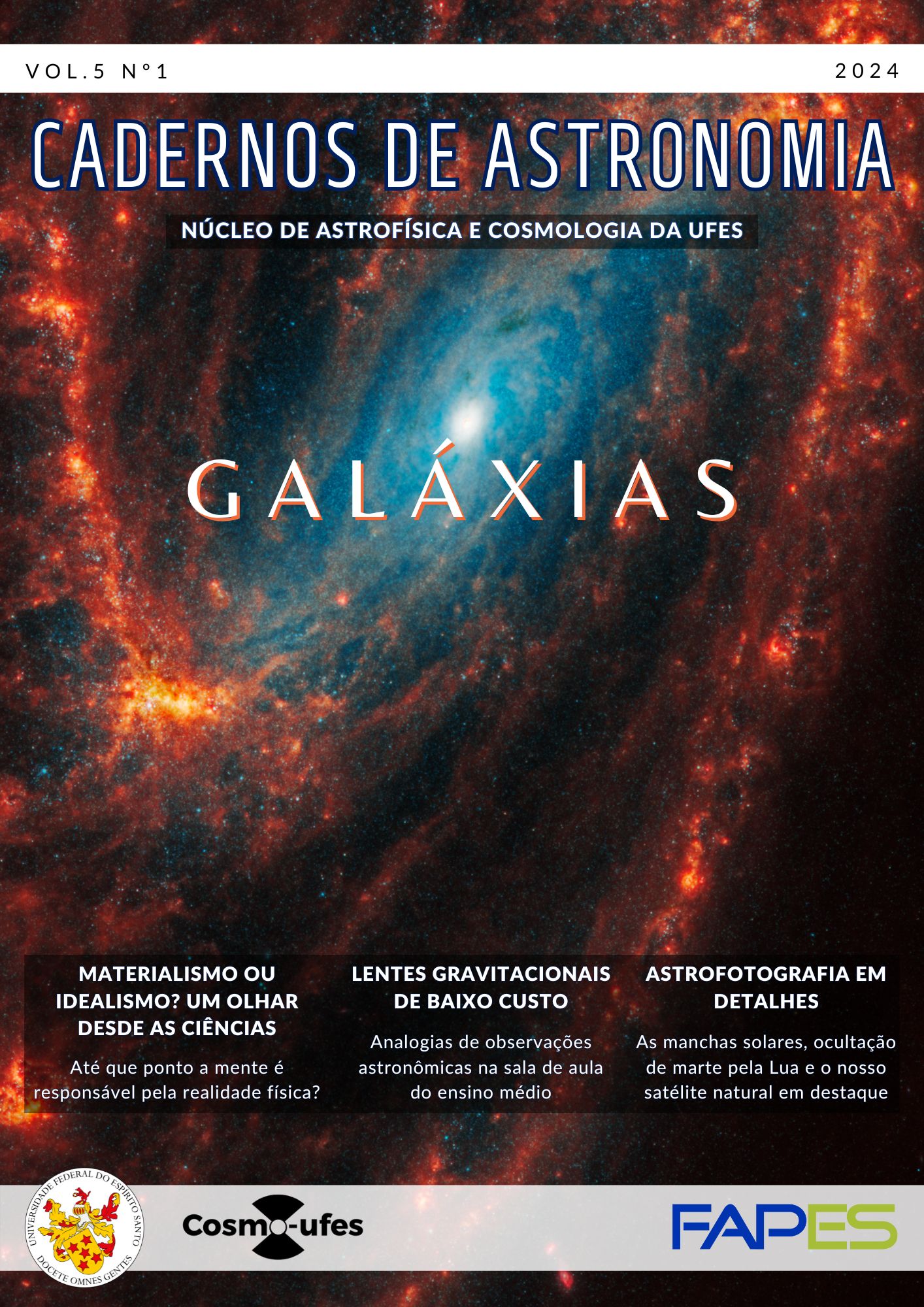Núcleos ativos de galáxias: uma breve introdução
DOI:
https://doi.org/10.47456/Cad.Astro.v5n1.43653Keywords:
núcleos ativos de galáxias, galáxias ativas, galáxias SeyfertsAbstract
Active Galactic Nuclei (AGN) are characterized by the presence of supermassive black holes (SMBHs) at their cores, which are involved in the acquisition of matter through an accretion disk. Within the AGN paradigm, a significant debate persists regarding the origin of this activity, encompassing triggering mechanisms and the impacts on dust and molecules in host galaxies. This work aims to describe the main observational characteristics of the classification and unification of active galactic nuclei, which can also be referred to in the literature simply as active galaxies.
Downloads
References
[1] C. Tadhunter, An introduction to active galactic nuclei: classification and unification, New Astronomy Reviews 52(6), 227 (2008).
[2] E. D. d. Santos et al., O caminho tortuoso de mulheres na ciência e na astronomia: evoulção e composição estelar a partir de estudos feitos por Cecilia Payne, Revista Vitruvian Cogitationes 4(extra), 246 (2023).
[3] P. C. Vieira, N. T. Massoni e A. Alves-Brito,
O papel de Cecilia Payne na determinação da composição estelar, Revista Brasileira de Ensino de Física 43 (2021).
[4] R. Antonucci, Unified models for active galactic nuclei and quasars., Annual Review of Astronomy and Astrophysics 31(1), 473 (1993).
[5] B. M. Peterson, An introduction to active galactic nuclei (Cambridge University Press, Cambridge, 1997).
[6] J. H. Krolik, Active galactic nuclei: from the central black hole to the galactic environment (Princeton University Press, Princeton, 1998).
[7] D. E. Osterbrock e G. J. Ferland, Astrophysics of gaseous nebulae and active galactic nuclei (University Science Books, Melville, 2006).
[8] L. C. Ho, Nuclear activity in nearby galaxies., Annual Review of Astronomy and Astrophysics 46, 475 (2008). ArXiv:0803. 2268.
[9] H. Netzer, Revisiting the unified model of active galactic nuclei, Annual Review of Astronomy and Astrophysics 53(1), 365 (2015).
[10] T. M. Heckman e P. N. Best, The coevolution of galaxies and supermassive black holes: insights from surveys of the contemporary universe, Annual Review of Astronomy and Astrophysics 52, 589 (2014).
[11] W. N. Brandt e D. M. Alexander, Supermassive black-hole growth over cosmic time: Active galaxy demography, physics, and ecology from Chandra surveys, Proceedings of the National Academy of Sciences 107(16), 7184 (2010).
[12] R. R. J. Antonucci e J. S. Miller, Spectropolarimetry and the nature of NGC 1068, The Astrophysical Journal 297, 621 (1985).
[13] R. Terlevich e J. Melnick, Warmers: the missing link between starburst and Seyfert galaxies, Monthly Notices of the Royal Astronomical Society 213(4), 841 (1985).
[14] A. Alonso-Herrero et al., Nuclear 11.3 μm PAH emission in local active galactic nuclei, Monthly Notices of the Royal Astronomical Society 443(3), 2766 (2014).
[15] A. Alonso-Herrero et al., A mid-infrared spectroscopic atlas of local active galactic nuclei on sub-arcsecond resolution using GTC/CanariCam, Monthly Notices of the Royal Astronomical Society 455(1), 563 (2016).
[16] C. M. Canelo et al., Profile comparison of the 6-9 μm polycyclic aromatic hydrocarbon bands in starburst-dominated galaxies, Monthly Notices of the Royal Astronomical Society 507(4), 6177 (2021).
[17] C. M. Canelo et al., Variations in the 6.2 μm emission profile in starburst-dominated galaxies: a signature of polycyclic aromatic nitrogen heterocycles (PANHs)?, Monthly Notices of the Royal Astronomical Society 475, 3746 (2018).
[18] C. M. Canelo, O mundo aromático dos PAHs no meio interestelar às condições bióticas, Dissertação de Mestrado, IAG, São Paulo (2016).
[19] M. G. Pastoriza, Studies of galaxies with peculiar nuclei, Astrophysics and Space Science 33(1), 173 (1975).
[20] R. A. Riffel et al., Mapping of molecular gas inflow towards the Seyfert nucleus of NGC 4051 using Gemini NIFS, Monthly Notices of the Royal Astronomical Society 385(3), 1129 (2008).
[21] R. Riffel, A. Rodriguez-Ardila e M. G. Pastoriza, A 0.8-2.4 μm spectral atlas of active galactic nuclei, Astronomy & Astrophysics 457(1), 61 (2006).
[22] E. A. Fath, The spectra of some spiral nebulae and globular star clusters, Lick Observatory Bulletins 5(149), 71 (1909).
[23] E. Y. Khachikian e D. W. Weedman, An atlas of Seyfert galaxies, ApJ 192, 581 (1974).
[24] D. E. Osterbrock, Observational model of the ionized gas in Seyfert and radio-galaxy nuclei, Proceedings of the National Academy of Sciences 75(2), 540 (1978).
[25] J. Runco, Frequency of Seyfert type transitions in a sample of 102 local active galactic nuclei, Trabalho de Conclusão de Curso, California Polytechnic State University (2015). Disponível em https://digitalcommons.calpoly.edu/physsp/128/, acesso em fev. 2024.
[26] M. Schmidt, 3C 273: a star-like object with large redshift, Nature 197, 1040 (1963).
[27] J. L. Greenstein, Redshift of the unusual radio source: 3C 48, Nature 197, 1041 (1963).
[28] T. M. Heckman, An optical and radio survey of the nuclei of bright galaxies - activity in the normal galactic nuclei, Astronomy & Astrophysics 87, 152 (1980).
[29] M. Berton et al., An orientation-based unification of young jetted AGN: the case of 3C 286, Frontiers in Astronomy Space Sciences 4 (2017).
[30] D. A. Sales et al., An embedded active nucleus in the OH Megamaser Galaxy IRAS16399-0937, The Astrophysical Journal 799(1), 25 (2015).
[31] R. D. Blandford e M. J. Rees, Some comments on radiation mechanisms in Lacertids, in Pittsburgh Conference on BL Lac Objects, Proceedings, editado por A. M. Wolfe (1978), 328–341.
Downloads
Published
Versions
- 16-03-2024 (2)
- 15-03-2024 (1)
How to Cite
Issue
Section
License
Copyright (c) 2024 Dinalva Aires de Sales

This work is licensed under a Creative Commons Attribution 4.0 International License.






